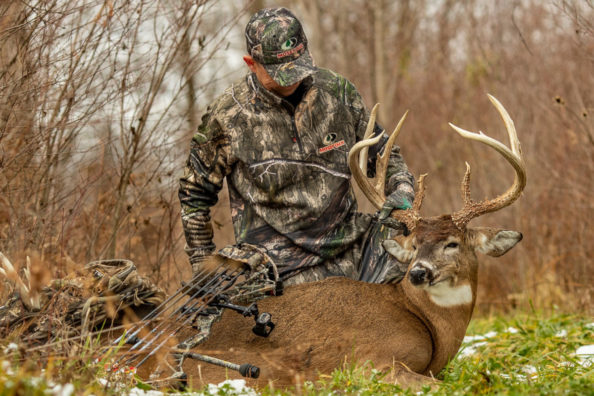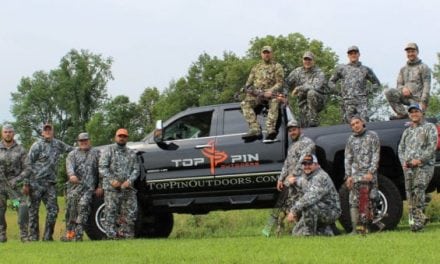
You can still screw up deer hunting the rut.
We are nearing peak breeding season for mule and white-tailed deer across the country, making this a prime time for hunters to bag a mature buck. Mostly because the big bucks are so focused on breeding activity, it is like they have blinders on to the rest of the world. An estrus doe can cause erratic rutting behavior that gets a big buck moving during the daylight hours when he is otherwise nocturnal.
While many a deer hunter has taken advantage of this breeding period to bag a big buck, you can just as easily screw everything up if you are not careful. Today we will cover some of the don’ts of hunting the deer rut.
Late October through late November can truly be a magical time of year each hunting season. Avoid these mistakes during each phase of the rut for the best odds of success this season.
Being too aggressive with calls/scents.
While many bucks are going to be worked up during the peak of the rut, this does not mean you should take a “one size fits all” approach to calling and rattling. Because what works well with deer populations in Iowa may not work as well during the peak of the whitetail rut in Michigan. Deer activity varies greatly depending on locations and the timing of the rut. Citing my home state of Michigan, we have a buck to doe ratio that is way out of whack. While bucks will still participate in sparring and fighting, most of it is not too aggressive. Mostly because these bucks don’t have to compete too much to find a receptive doe.
My trail cameras seem to confirm this suspicion year after year. Even my cameras on scrapes here in Michigan seem to indicate a less aggressive deer herd than the one I encountered in Wyoming. As a result, I think some of my past efforts using dominant buck urine and extremely loud grunting/rattling sequences may have done more harm than good. Before your hunt, carefully monitor rutting activity on cameras or through glassing from a distance to determine what you can get away with in calling sequence. In some places a simple tickling of your rattling antlers may be more effective than trying to simulate an all-out war. Here in Michigan, I like simply using an estrous scent on its own during the chase phase since it is less intimidating to bucks who are actively searching. In a place like Iowa or Missouri, you may need to use the dominate buck urine to rile them up more.
Not hunting all day.
We all know deer movement can be wildly unpredictable, but this seems to apply even more during the rut. This rule seems to apply more for the prime and less for the pre-rut and post-rut scenarios. Basically, staying on stand all day can allow gun and bowhunters a better chance at catching big game movements at midday. Once a buck gets locked onto a doe, he’s going to go where she goes. And often, those mature does decide to move at midday. If you are not on stand when she goes by, well, you’ve blown your chance.
Hunting all day does require a good amount of dedication and patience. However, there is a good reason why the most successful hunters stay out all day every day. Because a lot of these big guys are shot between noon and three p.m., times when most hunters are either at home or heading in for lunch. Anything can happen during the rut, and you must be there in the daylight to take advantage if you want to be successful.
Hunting one spot too much.
The deer may be continually hitting the same food sources or walking the same trails, but that does not mean you should keep hunting the same spot day after day. In fact, it’s a good way to ensure you never see that mature buck. Even when you think the big bucks may be blinded by estrus does and fawns, those older bucks still have sixth sense for danger. Many will recognize and pattern hunters who get a bit too predicable with where and when they are sitting.
Just remember, the first time you sit in a spot each season is likely to be the most productive. If you have a solid rotation of five to six stand sites, you can greatly increase your odds by never sitting in the same spot twice. If the bucks cannot pattern your activities, they are less likely to sense danger, and as a result, more likely to let their guard down in your hunting area. This can lead to an increased number of opportunities.
Throw out your pre-rut gameplan.
When it comes to hunting the rut, you can almost throw out all the data you’ve gathered on that big buck that was on your trail cameras through the summer and into the early fall. The rut is like a huge wild card in an Uno game. You never know what effect it will have on the deer. Some bucks may stick to the same areas they frequented through October. However, most of them will start to wander a bit in pursuit of hot does. Eight years ago, I dropped a gnarly, 10-pointer with some awesome mass on opening morning of firearms season. It was a deer we did not have on trail camera. My uncle had never seen the buck prior to that day.
When I shot him, he was hot on the trail of a hot doe. Which made it easy for me to a put a rifled slug through both lungs at 30 yards. That buck could have dogged that doe for a mile or more before they happened to wander in front of me.
The larger point is you can usually forget about all patterns once the rut rolls around. The buck could be in your hunting area one day and then be 10 miles away at dawn the next morning. One never knows exactly what a deer is going to do. If you go into the rut expecting a buck to stick to his pre-rut routines, you are likely setting yourself up for disappointment. The best option during the rut is to hunt the does and what they are doing. Where the does go, the bucks will follow.
Don’t forget about the wind and scent control.
While it is true that most bucks are more likely to throw caution to the wind during the rut, this does not mean you can do whatever you want in the woods with no consequences. Remember, the bucks may not be as cautious, but does are always on alert, even when they are in heat. If they sense danger and run, they are going to take that big buck with them. Being cognizant of the wind direction and the smell of your hunting clothing go a long way towards increasing deer sightings.
And I have noticed a marked increase in overall deer and shooter buck sightings since I started taking scent control more seriously a few years ago. The more doe sightings you have during the rut, the better the odds of seeing more bucks. Just because the deer are experiencing a marked difference in behavior does not mean they lose their instinct for danger. If you can fool those big, mature does, the bucks will not be far behind.
Overall, there are not too many ways to screw up hunting the rut. It is a magical time of year to be in the deer woods. I’ve seen more deer since I started putting the above tips into practice and you will too with a little hard work and determination.
Products featured on Wide Open Spaces are independently selected by our editors. However, when you buy something through our links, we may earn a commission.
For more outdoor content from Travis Smola, be sure to follow him on Twitter and check out his Geocaching and Outdoors with Travis YouTube channels.
NEXT: THE AXIS DEER AND HOW THEY’RE IMPACTING PARTS OF THE UNITED STATES
WATCH
The post 5 Ways to Totally Screw Up Hunting the Deer Rut appeared first on Wide Open Spaces.















